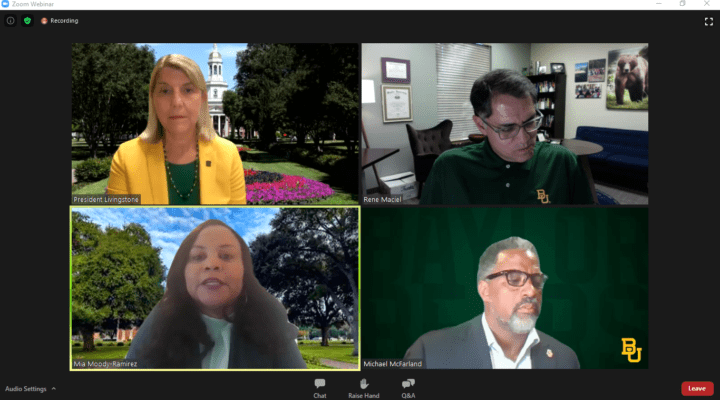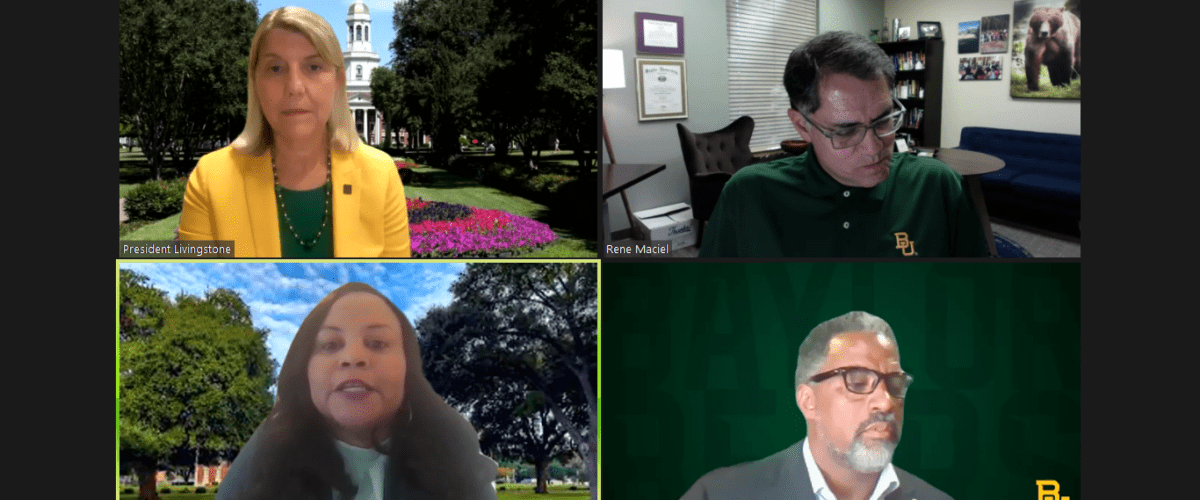An Instagram page where people of color share experiences of racism at Baylor University illustrates that the Baptist institution is still not where it wants to be on matters of racial inclusion, Baylor President Linda Livingstone said during a virtual town hall meeting Monday night, July 13.
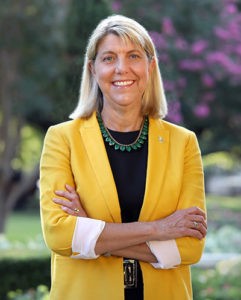
Linda Livingstone
Livingstone said she regularly recommends friends and colleagues read the personal accounts shared on the “Dear Baylor” site to understand the student perspective. “I periodically go on and read them, and frankly they are very heartbreaking.”
Livingstone joined U.S. Rep. Colin Allred, D-Texas, and Baylor regents René Maciel and Michael McFarland as featured guests on a Zoom event hosted by the Baylor Black Alumni Alliance and Baylor Alumni Latino Group.
Their discussion ranged from racism in Baylor’s history to the needs of students who are people of color to the diversity of faculty and staff and how the university’s Christian mission can be a catalyst on campus and beyond.
Discussion moderator Mia Moody-Ramirez opened by describing Baylor’s ongoing efforts to address racism on campus, including the establishment of a newly appointed commission of students, faculty and staff to examine the university’s history as it relates to slavery and racial injustice.
The COVID-19 pandemic, the death of George Floyd and the subsequent protest movement for justice have brought issues of systemic racism “to a tipping point” in the United States and at Baylor. These challenges also are opportunities for people and institutions of faith to show the way to healing, said Moody-Ramirez, chair of the Baylor department of journalism, public relations and new media.
“We can only imagine what is on the horizon,” she said. “As Christians, we have to take a leadership role in race relations.”
‘Tremendous opportunity for change’
Participants acknowledged Baylor’s shortcomings on race, but also spoke of the university’s accomplishments.
Baylor has the “foundational” elements in place to address its own racial issues and to set a positive example for other institutions, said Allred, a 2005 Baylor graduate and former NFL player who represents Texas’ 32nd Congressional district.
“All movements for change in our country were led by people of faith. Baylor is uniquely positioned to be part of that change.”
“All movements for change in our country were led by people of faith,” he said. “Baylor is uniquely positioned to be part of that change.”
But the change also must be internal, he added. The university needs to place greater emphasis on hiring and retaining diverse faculty and staff and become more welcoming to people of color when they arrive on campus as students.
Progress has been made along these lines in recent years, added Allred, who praised Livingstone for leading Baylor onto what he called a path of racial reconciliation in a time of pandemic and social unrest.
Playing football at Baylor provided Allred with the support he needed on the Waco campus as a Black man, and his alma mater helped him get into law school, he said. His hope now is that more non-athletes can come to expect the same treatment.
“Baylor was part of my American dream. … I want to make sure that experience is available to as many people as possible.”
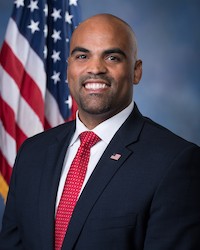
Colin Allred
Part of the solution lies in listening to students, said McFarland, who earned a bachelor’s degree and a doctoral degree at Baylor and serves as superintendent of schools in Crowley, Texas.
The university’s way forward must include people in authority hearing directly from students of color, he said. Not doing so creates animosity and feelings of isolation. “I guarantee you students can provide you the solutions.”
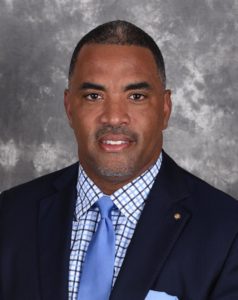
Michael McFarland
McFarland suggested offering the children of all Baylor employees, including groundskeepers, cafeteria workers and maintenance personnel, the reduced tuition rates available to children of faculty. Since many of those employees are people of color, such a program would contribute to student diversity.
Another approach could be arranging community service projects shared by Baylor student groups, he said. That would “encourage different ethnicities and cultures to perform projects together.”
Helping people of color feel more welcomed on campus can be accomplished by connecting them with Black and Hispanic business and religious leaders and communities off-campus, said Maciel, a 1991 graduate who has served as president of Baptist University of the Americas and of the Baptist General Convention of Texas.
“We really have a tremendous opportunity for change,” said Maciel, now missions pastor at First Woodway Baptist Church in Waco.
Those community leaders also could help in the recruitment of minority faculty and staff, he suggested. “We need to make them feel connected … and to look forward to being part of the Baylor family.”
“It’s heartbreaking that this is the experience many students of color are having on our campus.”
Diversity increasing
The challenges raised during the virtual gathering — and also those shared on Instagram — are not where Baylor wants to be, Livingstone said. “It’s heartbreaking that this is the experience many students of color are having on our campus.”
Student surveys have uncovered significant distrust of the university’s procedures for filing grievances and complaints on racial issues — which have been on the rise in recent weeks.
“We want that trust,” she said. “That is not the perception we want them to have. We want them to know we take those accounts seriously.”
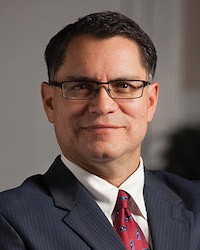
René Maciel
Slow-but-steady progress is being made on recruitment of people of color for faculty and staff positions, she added. More than 16% of faculty are minorities, up 1% over the last year but well above the 12% just a few years ago.
Retention of those faculty and staff is strong, she added, noting it’s the hiring that is the challenge. Search committees are now undergoing training to make hiring more inclusive.
The Baylor board of regents also is being diversified, she said. Today, 44% of regents are women and 18% people of color.
‘This is a spiritual matter’
The university also is looking into its past through the newly appointed Commission on Historic Campus Representations. That group’s mission includes examining founders’ roles in slavery and the Confederacy.
“That helps us in the process of redemption and healing to become a place that better represents Christ,” Livingstone said.
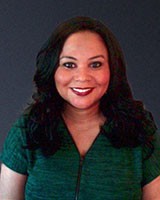
Mia Moody-Ramirez
But McFarland urged balance in that area. The good in Baylor’s history must be acknowledged, not just the bad. “We must acknowledge the entirety of it,” he said, citing specifically the role Baylor’s second president, Rufus Burleson, played in the founding of a Black college in 1881.
Whatever the challenges, Maciel said, issues of racial reconciliation must be seen for what they really are. “I really believe this is a spiritual matter. We have to look at it as spiritual.”
He suggested a day of prayer for justice and healing involving the university and Waco communities coming together.
Moody-Ramirez said she has been at Baylor 19 years. In that time there was a reported noose and black-face parties on campus and racial slurs hurled at Black students. But the image and reality has changed since those days, and there are more people of color on campus, she added.
While there is much more work to be done, “Baylor is moving in the right direction.”
Some in the Baylor community voiced disappointment that the town hall did not get to the question-and-answer session with audience members before time expired.
“I would have preferred more interaction and dialogue but can understand that can be difficult in today’s Zoom/WebEx world,” said Laura Cadena, a graduate of Baylor and the university’s George W. Truett Theological Seminary.
The topic of hiring of Hispanic faculty also needs to be addressed, she said, noting that hopefully a similar event in the fall will provide more time for questions.
“My overall takeaway of the event is that we have a lot of work ahead of us,” Cadena said. “There needs to be a mind shift from, ‘How do we help minorities feel comfortable on campus?’ which seems to put the burden on the student or faculty member, to Baylor doing some important self-examination.”

